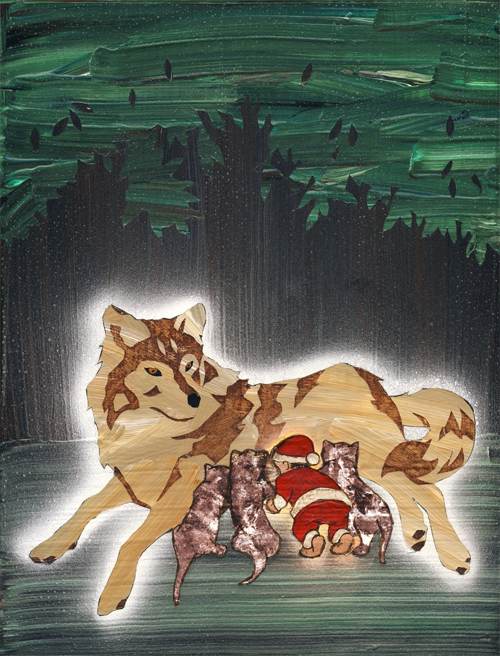The Ghost of Berserker Christmas
Don’t worry this Christmas if your grandfather shoots up the neighborhood—it’s all in keeping with 200 years of tradition that have been whitewashed by consumerism. How wild Christmas—night of carousing, gambling, and booze—became family-friendly.

Until the 1820s, it wasn’t unusual for groups of young men to celebrate Christmas by getting drunk, putting on their sisters’ clothes, and heading over to the boss’s house to scream and bang pots in the cold until they were offered a plate of food and a glass of liquor—or “figgy pudding and a cup of good cheer,” as a holiday drinking song of the day put it.[[1]]
That was the tradition, and it had been for years. After the farming was finished, the cellar was full, and the spirits had matured, it was time to blow off steam. “The Feast of Christ’s Nativity is spent in Reveling, Dicing, Carding, Masking, and in all Licentious Liberty,” wrote Cotton Mather in 1712.
But when the fieldwork moved to factories, when storerooms were swapped for city blocks, and when the density of young men changed from a rural few to an urban crowd, the upper classes, which once had uneasily acquiesced to a night of carnivalesque carousing, started to feel truly threatened.
Chief among these citizens was one Clement Clarke Moore, a New Yorker who ran with an aristocratic set known as the Knickerbockers. In 1818, Moore’s Manhattan estate, Chelsea—which stretched from what is now 19th Street to 24th Street and from Eighth Avenue to 10th Avenue—was chopped up by the city’s expanding street grid. From then on, he was forced to suffer the caterwauling and chaos of Christmas revelry first hand. Perhaps it played in the background as he sat down and scribbled, “T’was the night before Christmas….”
Formally titled “A Visit from St. Nicholas,” Moore’s yuletide poem first appeared in print on Dec. 23, 1823. It has run thousands of times since, helping to establish the modern Santa Claus (“He was chubby and plump, a right jolly old elf”), his physical traits (“He had a broad face and a little round belly”), his transportation choices (“a miniature sleigh, and eight tiny reindeer”), and even the tradition that he brings presents to children (“He spoke not a word, but went straight to his work, / And filled all the stockings”).
Within four decades of its publication, the poem—along with editorials and sermons from like-minded scolds, and the promotional pressures put on by shop owners, toy manufacturers, and others who saw they stood to financially benefit from a new sort of holiday—had redefined Christmas. Now no longer a night of potentially volatile social upheaval, it had become the family-friendly, home-focused, economy-boosting, stress-inducing, personal debt-exploding, suicide-rate-increasing knot of lights, tinsel, and spiral-cut ham that entangles us each December.
Before the Walmart bandits and Kmart samaritans who make news this time of year, there were screaming mobs and generous dollops of figgy pudding to scare and sate.
So what’s the moral of this strange history? The transformative power of poetry? The potential for a new Christmas tradition? Something about caroling, which is as near as anyone I know gets to the screaming and stumbling days of yore? Sure.
But it’s also more complicated than that. Christmas has always been filled with contradictions. Before the Walmart bandits and Kmart samaritans who make news this time of year, there were screaming mobs and generous dollops of figgy pudding to scare and sate. During the years that Santa Claus was finding his place in culture, I’d guess young boys fought for permission to go out for the night as they now argue about texting at the table or what video game to play when they finally do escape from supper.
I think there is a lesson to be learned from that sort of historical repetition: No matter how much we dress it up, change it around, unpack its legacies or try to make it fit into any one story, Christmas will always be more than just an orderly tradition, or a beautiful meal, or a thoughtful present, or even a liquor-fueled mob. It’ll always be a volatile carnival, stumbling with abundance, a smiling drunk, likely to get angry and then laugh and cry and fall asleep drained and stuffed with food. That’s the Christmas tradition I know best, and the strange history of pre-Santa Claus celebrations certainly reinforces it, as will the days to come. So don’t worry if the the 25th of December doesn’t turn out quite right. That’s what’s supposed to happen this time of year. That’s the real ghost of Christmas past.
[[1]]: This incredible piece of Christmas history and all the facts that follow are drawn from Stephen Nissenbaum’s The Battle for Christmas.
